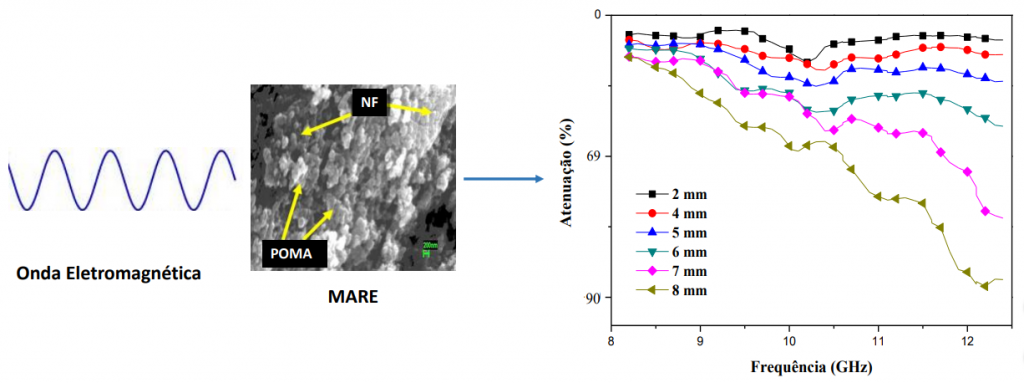By Julliane Silveira, scientific journalist, São José dos Campos, SP, Brazil
When radar absorbing materials (known under the acronym RAM) were first studied in the 1930s, researchers aimed to find materials that make some devices unnoticed by radars, when applied in targets. This technology is very useful in the manufacture of military vehicles, for instance, especially of aircraft. RAM are so named because they have properties that allow them to exchange the energy of the incident electromagnetic radiation by thermal energy (DIAS; MARTIN; REZENDE, 2012; WANG, et al., 2017).
Researchers could not imagine that such research would be useful in the 21st century, after the creation of many electrical and electronic devices such as mobile phones, radio transmitters, pacemakers and medical equipment (GAMA, REZENDE, DANTAS, 2011; DIAS; MARTIN; REZENDE, 2012).
As it happens to radars, these devices use electromagnetic waves on the GHz range and may suffer interference from other electromagnetic sources, what can disturb their operation. That is why researches still deep into this subject to find additives — or the mixture of them — that can be applied in RAM production to reduce or neutralize the electromagnetic interference.
This is the focus of the article “Performance Prediction of Microwave Absorbers Based on POMA / Carbon Black Composites in the Frequency Range of 8.2 to 20 GHz”, published in the vol. 10 of JATM (Journal of Aerospace Technology and Management) by researchers from Instituto Tecnológico de Aeronáutica (ITA) and Instituto de Ciência e Tecnologia (ICT) da Universidade Federal de São Paulo (Unifesp),
The two researchers analyzed the behavior of poly(o-methoxyaniline) polymer, also known by the acronym POMA, and carbon black. POMA is a material used in studies involving thin films as corrosion protectors, catalysis, battery electrode materials, biosensors and sensors. Carbon black, however, are black particles based on carbon element and generally available in the form of a very fine powder. It is commonly used in the manufacture of tires and printer inks.
“POMA and carbon black, when properly combined, result in a very efficient RAM. This absorber has the advantage over the magnetic based absorbers filled with ferrites and carbonyl iron, for example, to present lower density”, says Simone Souza Pinto, lead author of the study.
Figure 1 – Schematic of the wave-RAM interaction
The fact that they present lower density and high efficiency, as the article concludes, makes its production very relevant. “When the idea is to attenuate unwanted electromagnetic radiation without adding too much weight to the equipment, the use of these absorbers is a good option,” she explains.
This means that these materials can be used in the equipment production, which are vulnerable to electromagnetic interference, such as cell phones, TV signal transmitters and satellites.
The article further suggests the thicknesses more adequate for the studied materials, aiming increase the efficiency of RAM in the microwave attenuation. Research like this helps to increase the efficiency of devices without the need to increase their size or weight, which is crucial for new technologies, presented in ever smaller pieces.
References
DIAS, J.C., MARTIN, I.M. and REZENDE, M.C. Reflectivity of Hybrid Microwave Absorbers Based on NiZn Ferrite and Carbon Black. J. Aerosp. Technol. Manag. [online]. 2012, vol. 4, no. 3, pp. 267-274, ISSN: 1984-9648 [viewed 22 August 2018]. DOI: 10.5028/jatm.2012.04032512. Available from: http://ref.scielo.org/jjkkmh
GAMA, A.M., REZENDE, M.C. and DANTAS, C.C. Dependence of microwave absorption properties on ferrite volume fraction in MnZn ferrite/rubber radar absorbing materials. Magn Magn Mater [online]. 2011, no. 323, pp. 2782-2785, ISSN: 0304-8853 [viewed 22 August 2018]. DOI: 10.1016/j.jmmm.2011.05.052. Available from: https://www.sciencedirect.com/science/article/abs/pii/S0304885311003295
WANG, C., et al. Radar stealth and mechanical properties of a broadband radar absorbing structure. Compos Part B-Eng [online]. 2017, vol. 123, pp. 19-27, ISSN: 1359-8368 [viewed 22 August 2018]. DOI: 10.1016/j.compositesb.2017.05.005. Available from: https://www.sciencedirect.com/science/article/pii/S1359836816329407
To read the article, access it
PINTO, S.S. and REZENDE, M.C. Performance Prediction of Microwave Absorbers Based on POMA/Carbon Black Composites in the Frequency Range of 8.2 to 20 GHz. J. Aerosp. Technol. Manag. [online]. 2018, vol. 10, e1618, ISSN: 1984-9648 [viewed 22 August 2018]. DOI: 10.5028/jatm.v10.764. Available from: http://ref.scielo.org/8cn4vk
External link
Journal of Aerospace Technology and Management – JATM: <http://www.scielo.br/jatm>
Como citar este post [ISO 690/2010]:

















Recent Comments